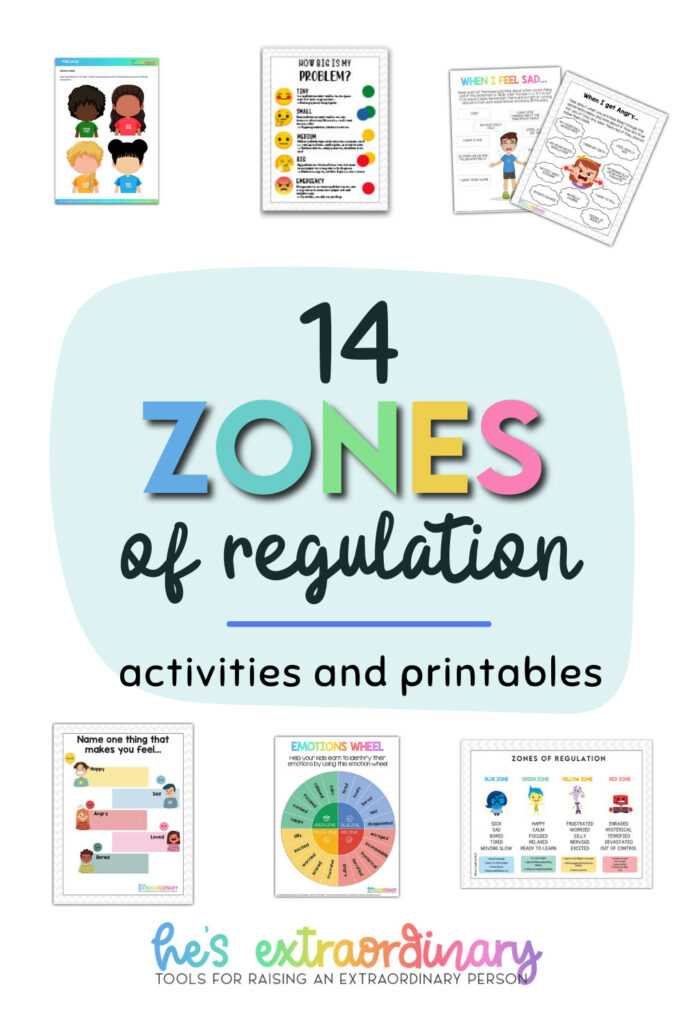Zones of Regulation Activities and Printables
What’s inside this article: Various Zones of Regulation activities and printable worksheets, which can be used by counselors, teachers, or parents, as supplemental activities for teaching and reinforcing concepts from The Zones of Regulation curriculum.
The key to successfully teaching the Zones of Regulation is to spend lots of time solidifying the Zones concepts through repetition and play-based learning activities.
These Zones of Regulation activities and printables will help you do just that.
If the Zones of Regulation is new to you, make sure you read this overview of the Zones for parents, first.
There are a few main components to the Zones that your child should learn sequentially to be successful.
Zones of Regulation Learning Objectives:
- What the four zones are and which emotions belong to each zone.
- How to identify which zone you are in
- What triggers are cause you to move out of the green zone.
- How to recognize what zone others are in
- Strategies to move back to the green zone from yellow, blue, or red
- Expected behavior vs unexpected behavior
- Size of the problem
- How your actions affect what zone other people are in (comfortable and uncomfortable thoughts)
Zones of Regulation Activities
These Zones of Regulation activities and printables all support the learning objectives above.
1. 22-Page Zones Bundle
I created this 22-page bundle of free zones of regulation printables to make it a bit simpler for people downloading a lot of items from this list. It contains all the freebies in the list, but you’ll also find some free printables exclusive to this bundle, such as “size of the problem” activities, and two different visuals of the four zones.
You can download this free bundle here.

1. Which Zone Would I Be In If…
This is a simple, printable matching game to help children think about the zones. There are 30 cards, each with a different scenario on it and a main matching page with the four zones, and instructions.
Get your child to choose a card, read it, and then place it on top of the color zone that they think they would be in if the scenario happened to them.
There are no right or wrong answers in the game, the sole purpose is to get children thinking about the zones and about their feelings.
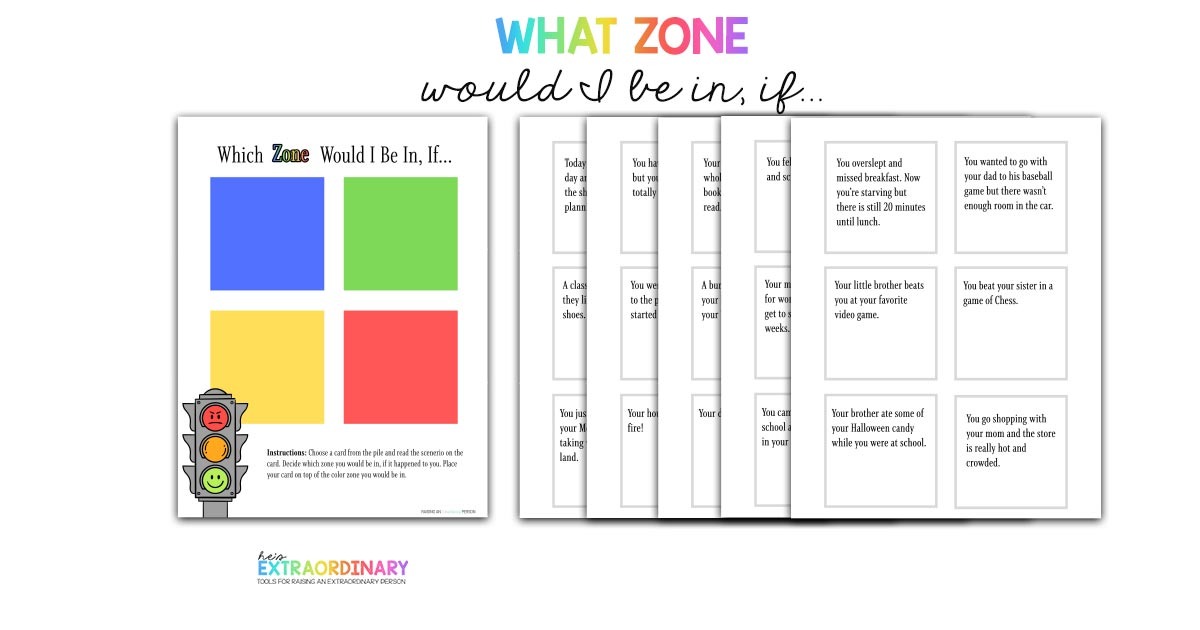
Which Zone Would I Be in IF…
Includes 30 cards with hypothetical situations, and a page for sorting the cards into the Zones. Read the cards with the kid(s) and decide which zone THEY feel they would be in, if this happened to them. You can ask questions about why, to open a discussion.
2. Which Zone are THEY in?
This game is a lot like the first game, only this time there are different images on the cards of various characters’ faces.
The goal of the game is for your child to analyze the character’s face to determine which zone they’re in.
Then they should place the image on top of the correct color zone.
This game helps children with perspective-taking and encourages them to pay attention to and recognize how other people are feeling.
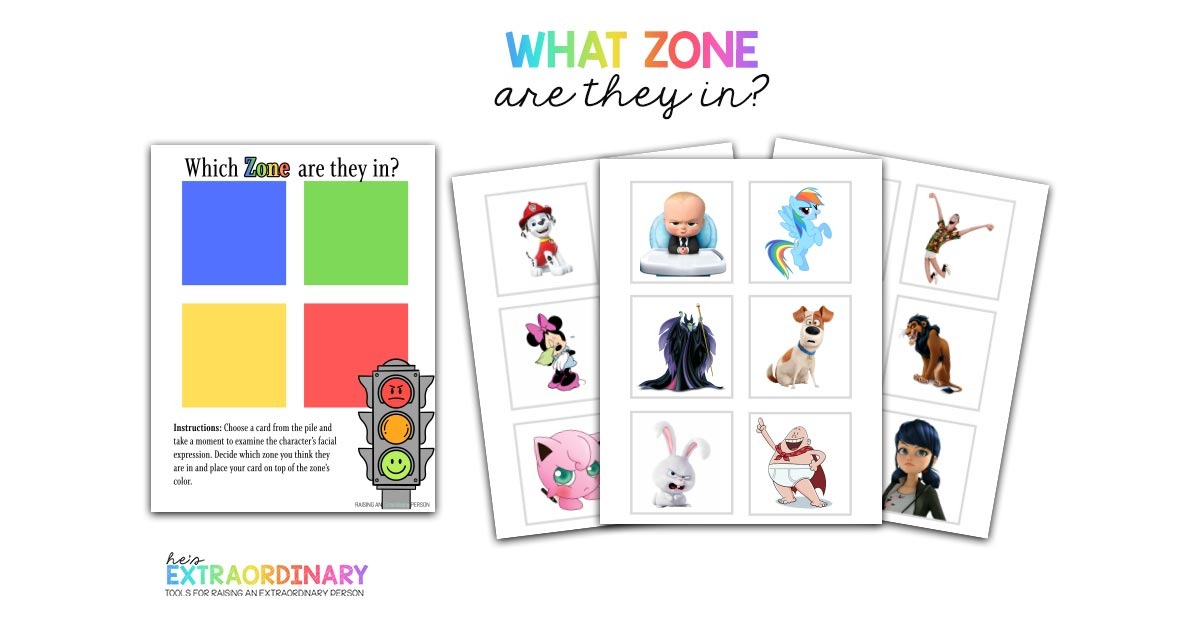
What Zone Are THEY In?
Have your children analyze the expressions and body language of these popular cartoon characters and determine which Zone they’re in. Sort them on the colored squares based on Zone. This game helps children with perspective-taking and encourages them to pay attention to and recognize how other people are feeling.
3. Zones of Regulation Bingo
Zones Bingo from The Zones of Regulation has been adapted by Alex Hirsh for students familiar with Boardmaker® feelings visuals. I love this activity because it helps kids using board maker visuals (often children with autism) become familiar with the symbols for various emotions.
You can print the Zones Bingo from the official Zones website here.
4. When I Get Angry…
Help your child recognize what anger (red zone) feels like in their body.
Not everyone has the same physiological response to anger. Still, there are some pretty common responses, and we all experience some of them.
Go through each of the anger cues on the free printable with your child, and if they feel that the statement is true for them when they’re angry, color it red.
There are no right or wrong answers; everyone experiences anger differently, and this helps your child be more aware of what happens to them when they’re in the red zone.
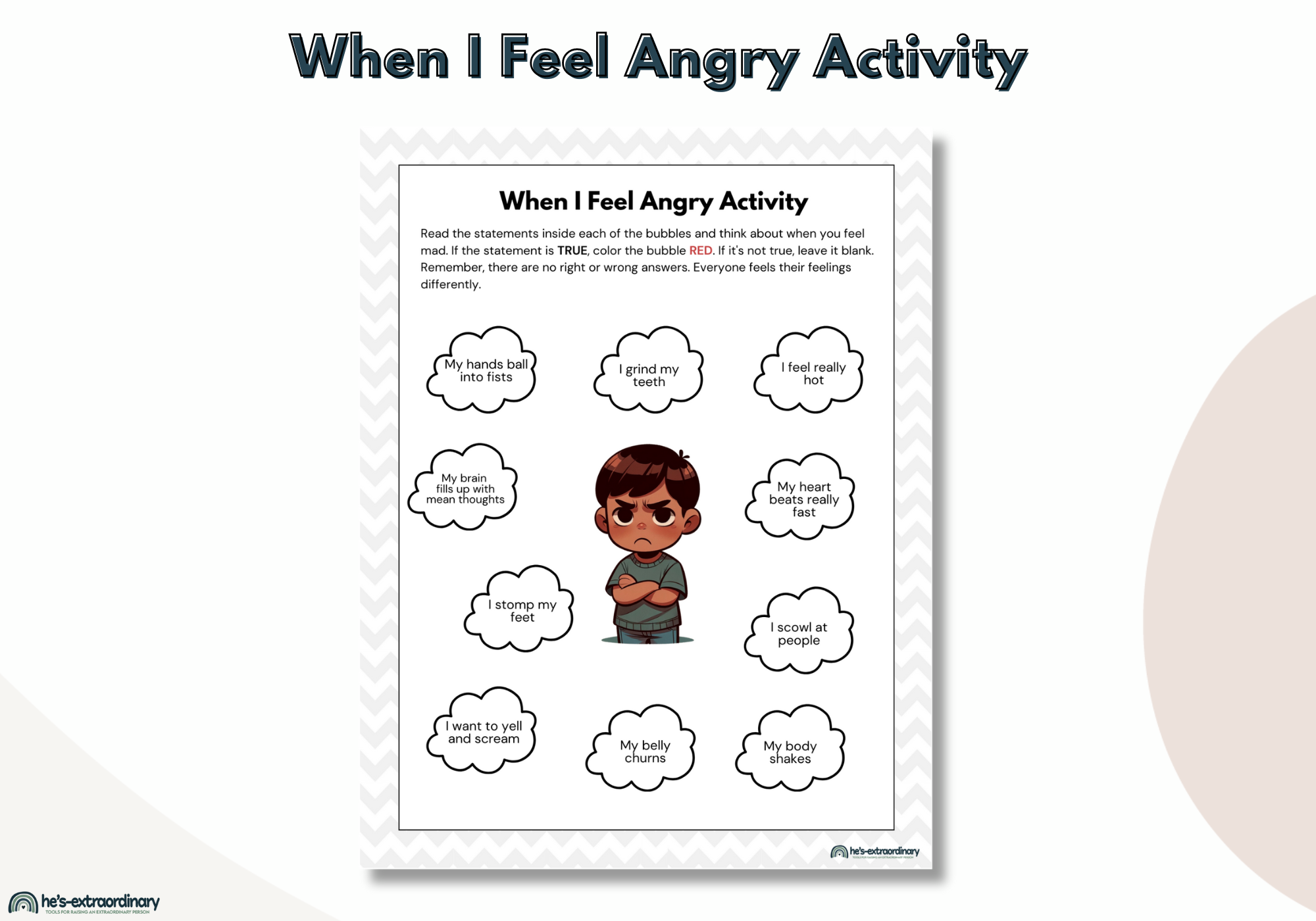
When I Feel Angry…
Help your child learn to recognize the physiological effects of anger. Go through each anger cue on the free printable with your child, and if they feel that the statement is true for them when they’re angry, color it red.
5. When I Feel Sad
A lot of times, when children feel sad, they actually behave angrily. It may be because they don’t really know what’s going on inside them.
This coloring activity helps get kids thinking about some of the hard feelings associated with sadness that they may feel too vulnerable to share aloud with others.
It creates an opportunity to open a conversation around sadness, where you can reinforce that sadness is normal and temporary, and they can share that feeling with you safely.
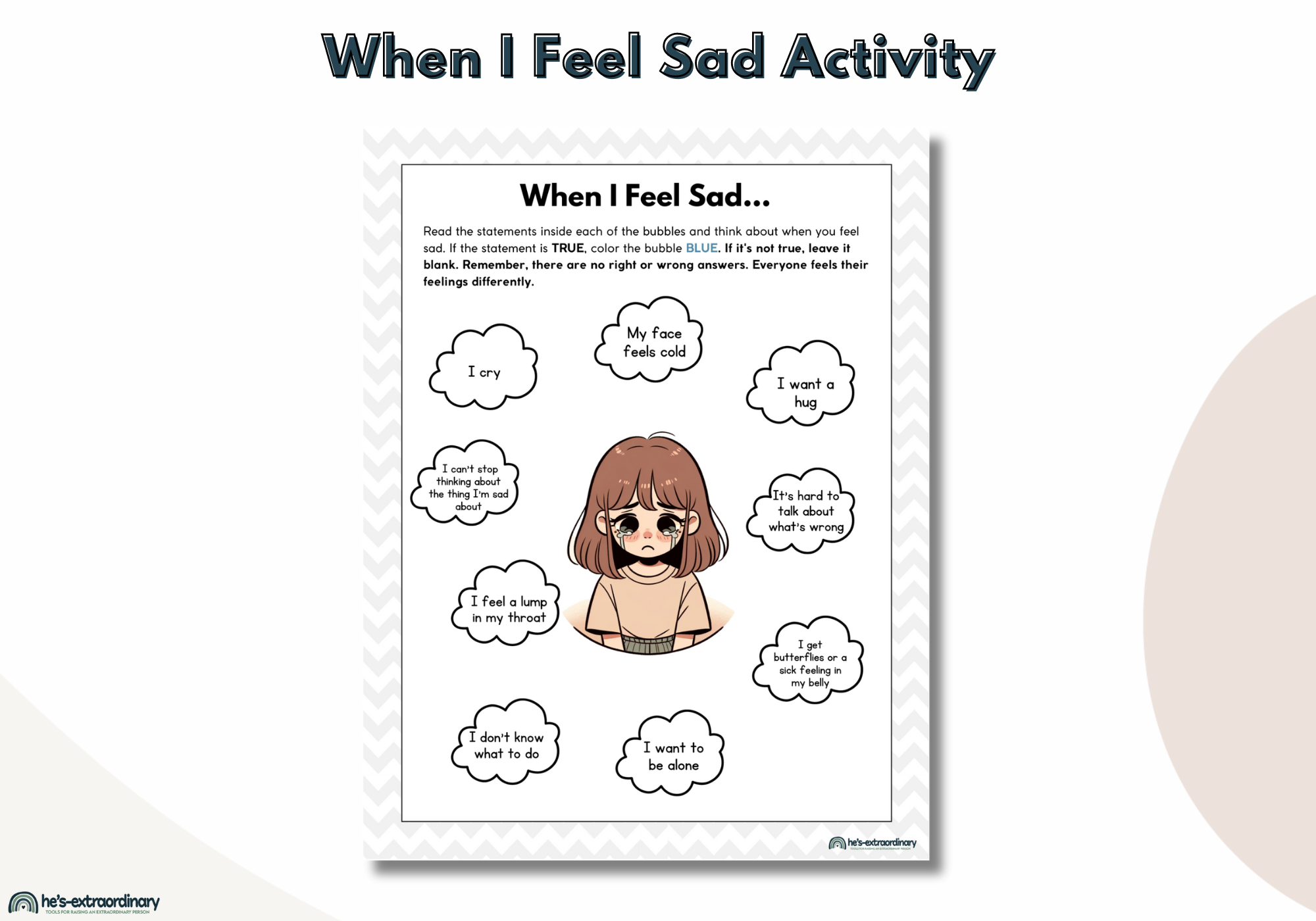
When I Feel Sad…
This coloring activity helps get kids thinking about some of the hard feelings associated with sadness that they may feel too vulnerable to share aloud with others.
6. Anger and Sadness Booklet for Kids
Social scripts, lessons, discussion questions, and activities related to coping with anger and sadness. Fillable PDF format.
- Feeling mad social script ($4 value)
- Feeling sad social script ($4 value)
- Feeling grumpy social script ($4 value)
- Coping Skills for Anger and Sadness ($6 value)
- Using Self-control script and STOP strategy ($3 value)
- Time & Space lesson and discussion ($3 value)
- Expressing feelings with I statements, lesson, and activity ($5 value)
- FEEL-mometer – measuring intensity of feelings ($5 value)
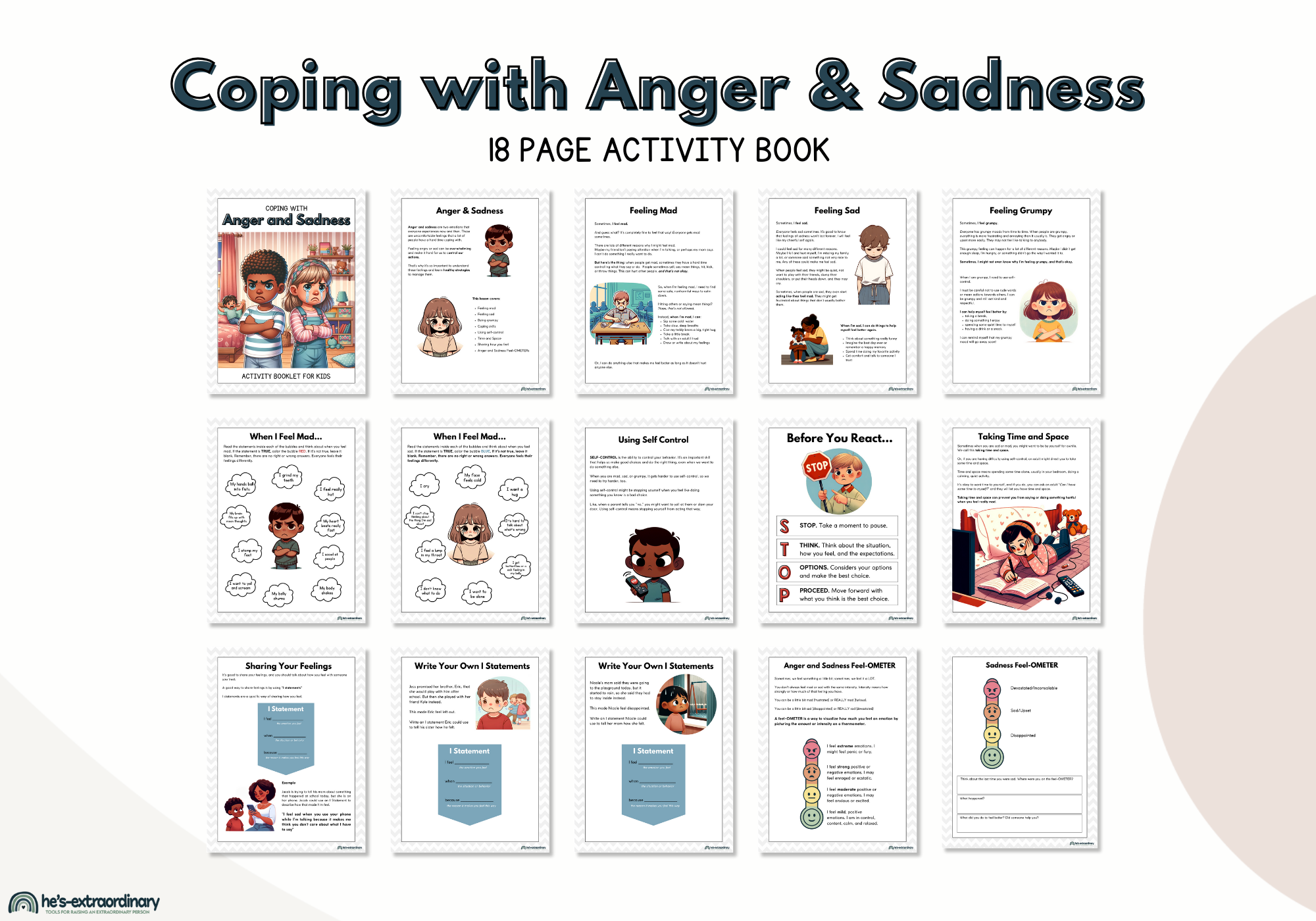
Anger & Sadness Booklet
18-page activity book with social scripts, lessons, discussion questions, and activities related to coping with anger and sadness. For ages 5-9.
7. Interactive Zones Package
This package is available from Teachers Pay Teachers. It includes:
This package is excellently illustrated, and the interactive activities and reference visuals are great for elementary-age kiddos.
The package is available on TPT here.
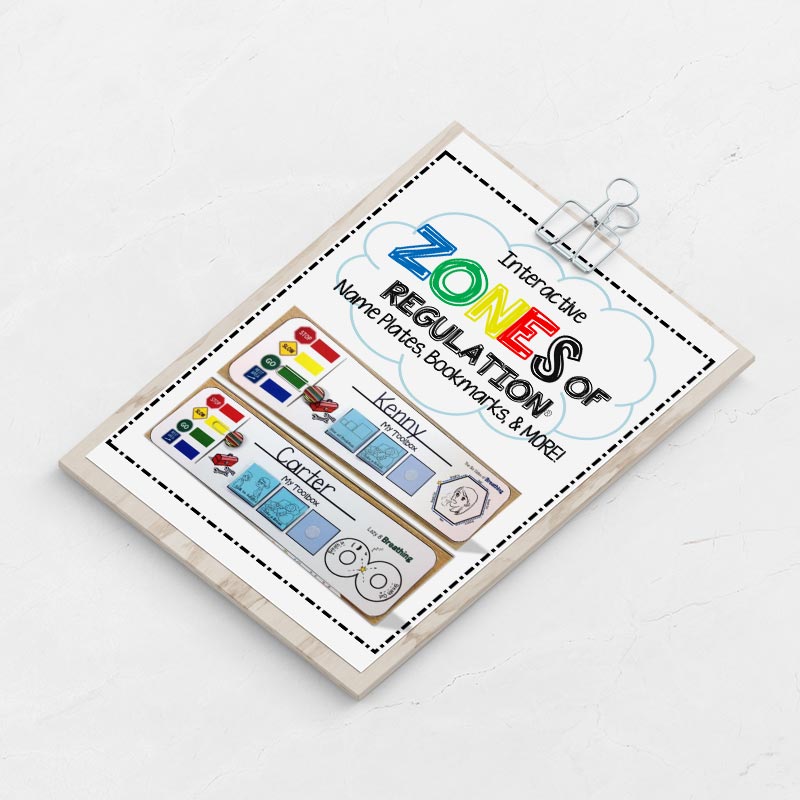
8. Don’t Take The Bait
Don’t Take The Bait is a game that I first played with my own kids after my son brought it home from school. They played this game at school as part of their Zones of Regulation curriculum.
This game helps children learn to identify their triggers. In the game, the “bait” is the trigger.
Kids have to choose an effective coping strategy to use, rather than negatively reacting to the trigger (bait).
Kids can act out different situations during the game, demonstrate coping strategies, and even have a little fun acting out negative reactions. It’s a fun way to practice the skills covered by the Zones.
You can get this game from TpT here.
9. Wheel of Emotions for Kids
This wheel of emotions is loosely based on Plutchik’s emotion wheel but themed around the zones of regulation. making it kid-friendly.
It’s created to be used as a tool for kids who can identify which zone they’re in to start using more complex emotive words to describe their emotions.
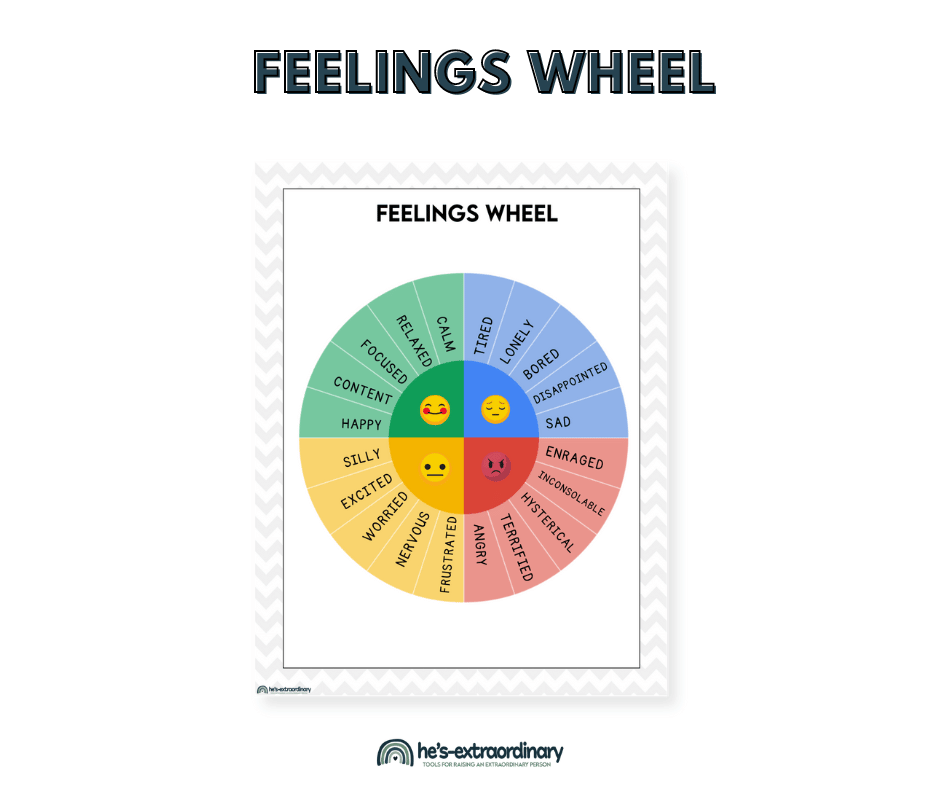
Feelings Wheel Printables
This wheel of emotions is loosely based on Plutchik’s emotion wheel but themed around the Zones of Regulation, making it kid-friendly.
10. Communication: Aggressive vs. Assertive
This four-page printable can be used as a tool for teaching children to communicate assertively rather than aggressively. (This is also included in the social skills mega bundle; learn more here)
This is helpful for children who become explosive when they don’t get their way.
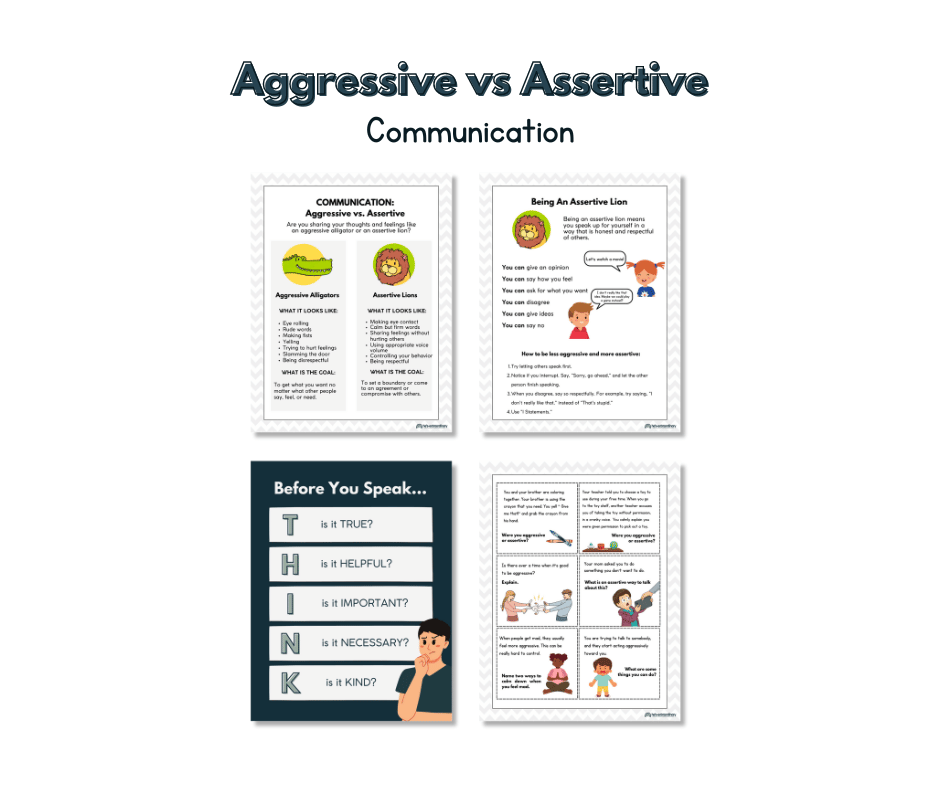
Assertive Vs. Aggressive Communication
This four-page printable can be used as a tool for teaching children to communicate assertively, rather than aggressively.
11. Name One Thing…
This activity comes in fillable PDF format which is great for those doing distance ed or teletherapy, but you can print it out and use it as a worksheet, too.
Children are shown different, common emotions and asked to name one thing that makes them feel that way.
This is free to download here.
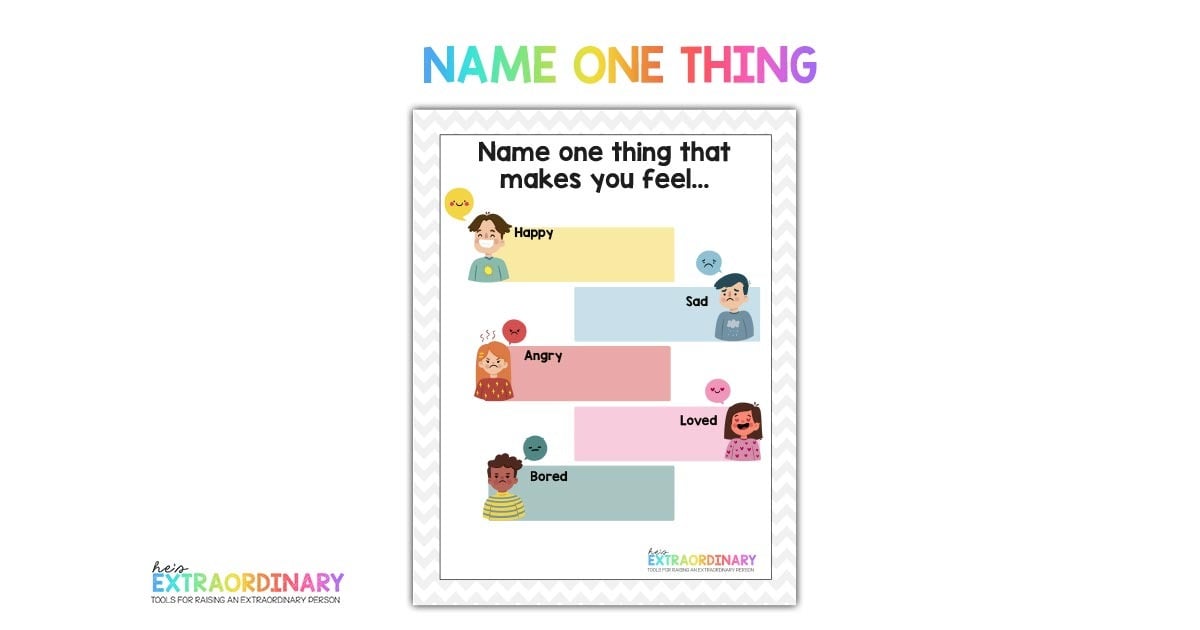
Name One Thing…
This simple activity gets children thinking about some common emotions and what type of things make them feel that way. Fillable PDF.
12. Draw A Face – Zones Activity
Kids draw faces on four different, blank character illustrations – each one is wearing a shirt to represent one of the four Zones of Regulation.
Kids can draw a different face on each character to represent the zone they’re in. This helps with categorizing emotions by zone, as well as reading facial expressions.
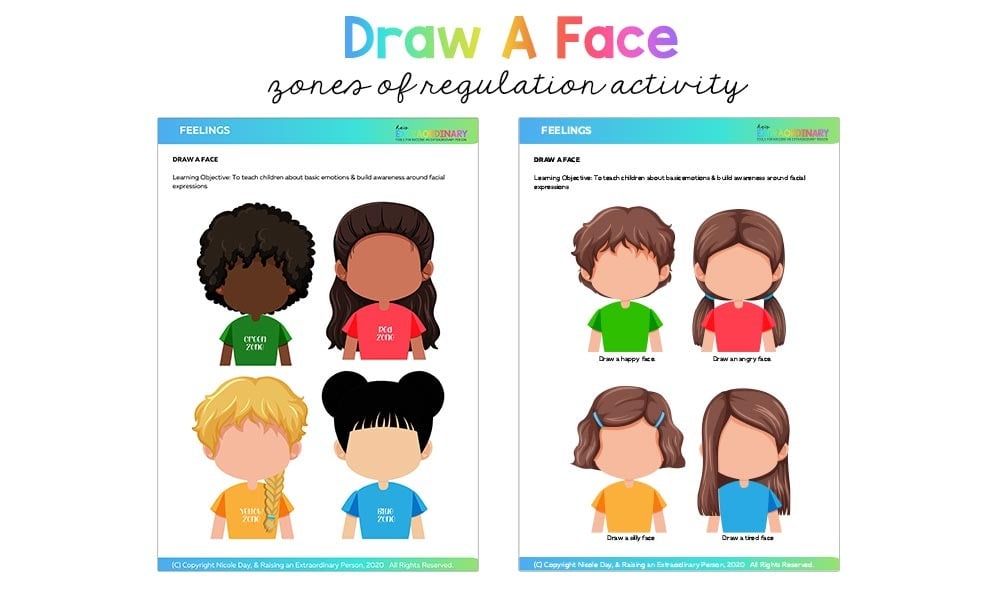
Draw A Face
Draw different faces on each of the four characters to represent the different zones.
13. Identifying The Zones Interactive Google Slides
You can use this in Google Classroom, for example, with students or using Microsoft PowerPoint. There are drag-and-drop elements for children to sort based on Zone. Each slide has a different interactive activity that helps children practice identifying the Zones.
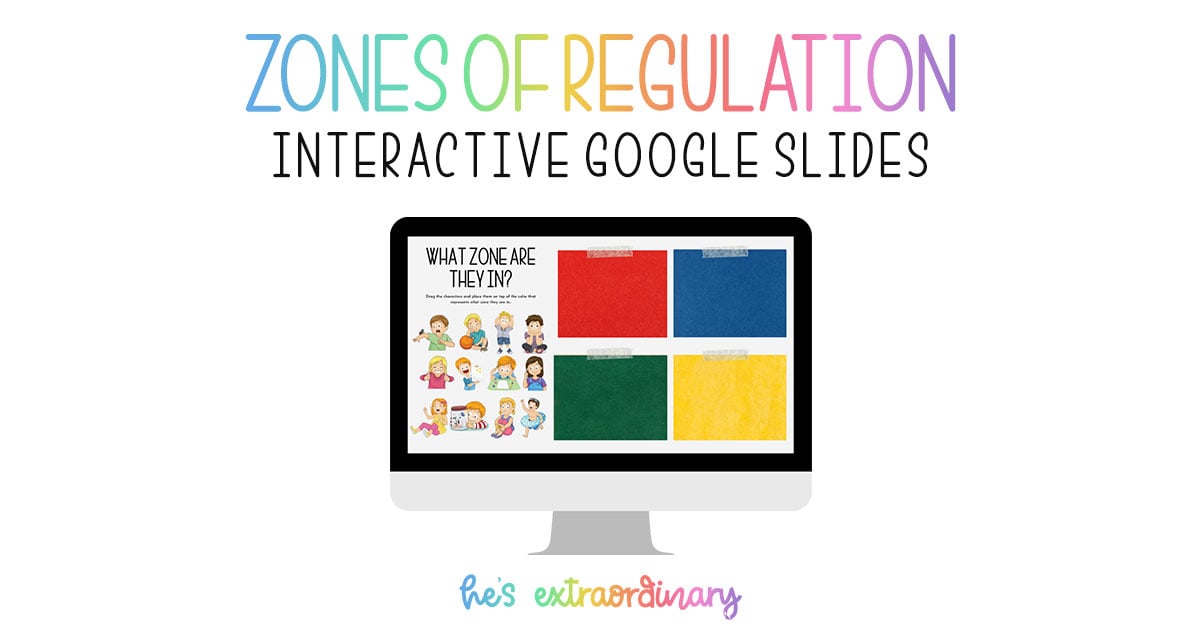
Identifying The Zones – Google Slides
Interactive Google Slides for practicing identifying the Zones. Each slide contains a drag and drop activity. To Use: 1. Download the file 2. Save to Google Drive 3. Open with Google Slidesm
14. Inside Out Zones of Regulation Chart
This chart is illustrated with characters from the Inside Out movie to represent the four zones. It includes a list of emotions for each zone, as well as a short description of what a person may look like or act like in each zone.
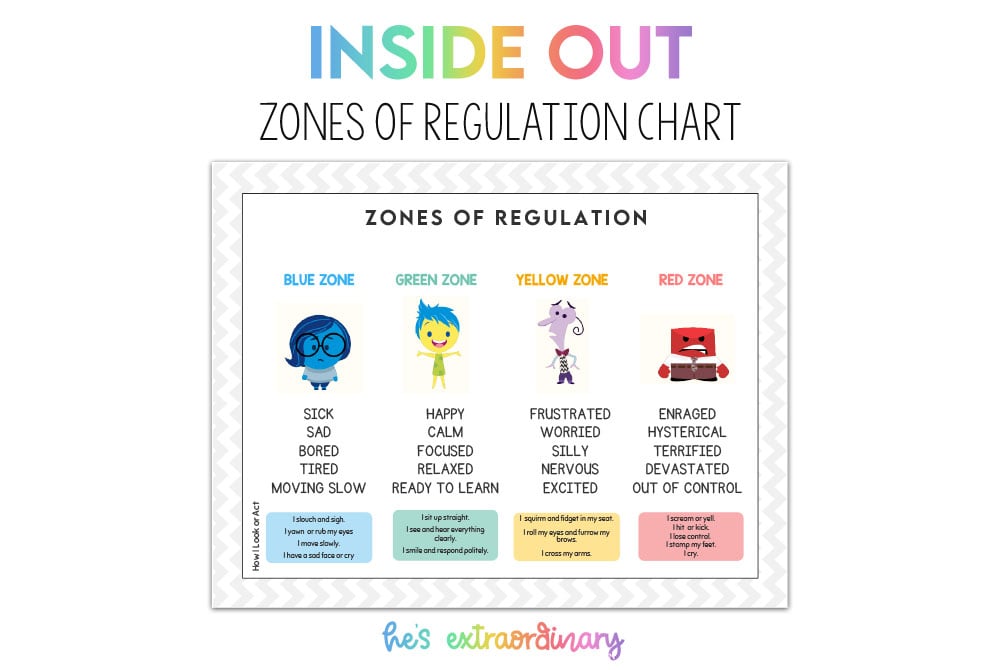
Inside Out Zones Chart
This Zones of Regulation chart has the characters from the movie Inside Out to represent each of the four zones. It includes a short description of what someone may look or act like in each zone.
15. Intro to The Zones PowerPoint Presentation

Inside Out Zones Chart
12 slide PowerPoint presentation to introduce The Zones of Regulation and encourage students to start talking about the zones. These are editable in Microsoft PowerPoint.
Official Zones of Regulation Posters
The official Zones of Regulation Posters are only available by purchasing them from Social Thinking.
This is where you can also access the curriculum and all of the other official learning resources.
The activities within this blog post are all adapted from the original Zones created by Leah Kuypers.
Schools, clinics, therapists, and counselors worldwide use the Zones Framework and activities such as these ones to teach emotional self-regulation to children.
